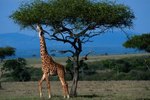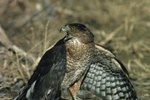
The tropical grasslands of eastern Africa, where droughts and monsoons alternate, support some of the greatest mammal diversity on Earth, including a few species with superlative characteristics. Ungulates, or animals with hooves, are among the most prevalent. Known as savannas, these grasslands are also home to large, terrestrial birds and fearsome reptiles.
Carnivores
Atop the East African savanna food web is the African lion, the only feline that forms social groups, known as prides. Lions prey on antelopes, giraffes, warthogs, buffalo and even small rhinoceroses. The cheetah, the planet's fastest terrestrial creature with a maximum speed of 64 miles per hour, hunts mostly hoofed animals, like antelope and zebra. Smaller cat species include the caracal and the serval, which consume birds, frogs and reptiles. Other native carnivores include the spotted hyena, also known as laughing hyena due to its vocalizations, and the endangered African wild dog, which hunts in packs.
Antelopes
Antelopes -- herbivorous, hoofed animals with permanent horns -- are some of the most pervasive grassland species and a favorite prey of the carnivores. They include the nomadic wildebeests, over a million of which migrate every year from Tanzania's Serengeti plains to Kenya's Maasai Mara reserve and back in search of verdant fields on which to graze. Also common are the Grant's gazelle, Thomson's gazelle and the impala.
Other Herbivores
Many iconic mammals of the eastern African plains are herbivores, including the African elephant, hippopotamus and black rhinoceros, which rank among the largest terrestrial animals anywhere. Warthogs, wild pigs found south of the Sahara desert, are grassland-dwelling herbivores that eat grasses, berries and bark, but have also been known to feed on carrion. Hippos, rhinos and warthogs are ungulates, as are zebras, which also graze on the grasslands of East Africa. Several subspecies of giraffe, the tallest animal on Earth, also occur in the region, including the Maasai giraffe and the reticulated giraffe, which are native to Kenya.
Birds
The eastern African grasslands boast enormous bird diversity; the Maasai Mara reserve alone is home to 450 species. The omnivorous and flightless ostrich, the planet's biggest bird, runs as fast as 43 miles per hour throughout the savannas, which also harbor the kori bustard. Though capable of flying when threatened, kori bustards are some of the world's heaviest birds -- males can weigh up to 40 pounds -- and therefore rarely leave the ground. Species found exclusively in East Africa include the grey-breasted spurfowl and the brightly colored Fischer's lovebird.
Reptiles
The reptile population in the eastern Africa grasslands includes the venomous black mamba, one of the deadliest snake species in the world. Rocky granite outcroppings throughout the savanna provide homes for the African pancake tortoise, which has a flat, flexible shell that enables it to escape predators by hiding in crevices. The Nile crocodile, which inhabits rivers and streams throughout sub-Saharan Africa, is the continent's largest reptile. Most are approximately 16 feet long. Indiscriminate carnivores, they eat fish, but will also attack wildebeest, zebras, young giraffes and even small hippos.
References
- Smithsonian National Zoological Park: African Savanna Exhibit
- Smithsonian National Zoological Park: Cheetah Fact Sheet
- Zoo Atlanta: Kori Busstard
- World Wildlife Fund: East African Acacia Savanna
- San Diego Zoo Animal Bytes: Antelope
- World Wildlife Fund: Maasai Mara
- Bristol Zoo: African Pancake Tortoise
- African Wildlife Foundation: Thomson's Gazelle
- Defenders of Wildlife: African Lion
- National Geographic: Nile Crocodile
Resources
- San Diego Zoo Animal Bytes: Spotted Hyena
- San Diego Zoo Animal Bytes: Serval
- African Wildlife Foundation: African Wild Dog
- National Geographic: Ostriches
- San Diego Zoo Animals: Giraffe
- San Diego Zoo Animals: Elephant
- National Geographic: Black Mamba
- African Wildlife Foundation: Impala
- San Diego Zoo Animal Bytes: Warthog
- National Geographic: Hippopotamus
Photo Credits
-
Anup Shah/Photodisc/Getty Images
Writer Bio
Since beginning her career as a professional journalist in 2007, Nathalie Alonso has covered a myriad of topics, including arts, culture and travel, for newspapers and magazines in New York City. She holds a B.A. in American Studies from Columbia University and lives in Queens with her two cats.




